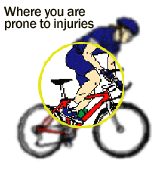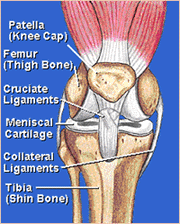Working out can exact a painful cost. We check out the most common sports injury in women and how it need not dampen your active life.
By Ng Min Li
Physiotherapist The most common sports injuries occur in the knee, shoulder and elbow joints. Approximately 55% of athletic injuries occur in the knee. Also, it was reported recently that one in ten female college athletes in the United States suffer from a major knee injury every year.  The next most frequently injured joint in sports is the shoulder. It accounts for approximately 20% of sports injuries. The elbow is the third most frequently injured joint, accounting for about 7% of sports injuries. While most research supports the notion that injury rates are generally more sport specific rather than gender specific, there are some exceptions though. In a report published in 1995 by the National Collegiate Athletic Association (NCAA), the data showed that female basketball and soccer players have a significantly higher incidence of knee injuries than their male counterparts. In Singapore, women who work out list brisk-walking, running or jogging and aerobics as their most preferred activity, according to the National Health Survey of 1998. It is a good idea to be aware of how to protect our knees as we age so that we can continue to get the most from our workouts. Why Knees Are Vulnerable
The next most frequently injured joint in sports is the shoulder. It accounts for approximately 20% of sports injuries. The elbow is the third most frequently injured joint, accounting for about 7% of sports injuries. While most research supports the notion that injury rates are generally more sport specific rather than gender specific, there are some exceptions though. In a report published in 1995 by the National Collegiate Athletic Association (NCAA), the data showed that female basketball and soccer players have a significantly higher incidence of knee injuries than their male counterparts. In Singapore, women who work out list brisk-walking, running or jogging and aerobics as their most preferred activity, according to the National Health Survey of 1998. It is a good idea to be aware of how to protect our knees as we age so that we can continue to get the most from our workouts. Why Knees Are Vulnerable
A woman's lower leg alignment (wider pelvis, greater angulation of the thigh bone and greater angulation at the knee) is different from a man. Many experts believe that this may be related to injury but there are few quality studies that support a causal relationship between lower leg alignment and injury. Another idea that has been widely discussed but again not proven by quality research is that women have greater ligamentous laxity. Many researchers have tried to relate loose-jointedness to increased injury incidence. However, there are conflicting research findings about the relationship between joint laxity and injury rates. Some studies have suggested that athletes who are loose jointed are at greater risk of injury than those with normal or "tight" joints. Other studies, however, have shown no relationship between native joint laxity and injury. The cyclical effects of women's hormones on soft tissues may contribute to joint laxity but once again, this relationship and its possible link to injury is not well understood and requires further research. What Knee Injuries Mean
Whatever the reasons for women's weakness in the knee joint, the fact is that forces generated by twisting, jumping, running and climbing can also damage several structures in the knee.

The common injuries in the knee are:
Meniscus Tears
The two C-shaped cartilage pads (known as menisci) sitting between the thigh (femur) and shin (tibia) bones provide a smooth bearing surface to facilitate motion and absorb shock. Twisting and pivoting on your weight-bearing knee generate forces that may tear these cushioning structures.
Patellofemoral Disorders
"Patellofemoral disorders" is a general term for injuries that arise from the patella (knee cap), quadriceps muscles (the front thigh muscle), patellar tendon and other soft tissues around the patella. Patellofemoral disorders are observed more often in women than in men. The patella experiences tremendous forces in running and jumping sports and may become irritated or roughened with prolonged athletic activity. Pain arising from the overloaded patella can be aggravated by a poor lower leg alignment and weak inner quadriceps muscles (known as the vastus medialis oblique) which are commonly observed in women. Ligament Injuries
Injury to the anterior cruciate ligament (ACL) is the most disabling of ligament tears and often requires surgical treatment. Ligaments are fibrous bands that connect the bones of the knee and provide stability to the joint through the full range of motion. They may be torn in pivoting sports. The ACL provides stability to the knee by preventing excessive forward movement of the tibia (shin bone) on the femur (thigh bone). Without the ACL, the knee buckles easily during pivoting sports and is prone to other injuries. The NCAA report showed that ACL injuries were significantly more common among women. The injury rate for female soccer players was over two times higher than for male players, and female basketball players were four times more likely to sustain an ACL injury than male players. Recent studies presented at the American Academy of Orthopaedic Surgeons meeting in Orlando this year confirmed that females have more injuries to their anterior cruciate ligaments. One reason for this higher incidence is that men and women jump differently. The study found that women expose their knee joints to higher impact forces for every pound of body weight when landing from a jump, compared to men because they do not flex their knees enough. Thus, training programs should teach female athletes proper landing methods and other injury prevention techniques. Another study also found that women use their thigh muscles differently from men; females tend to activate their quadricpes muscles during some exercise, which may put them at a higher risk of ACL injuries. By altering the training programmes, female athletes may be able to reduce the risk of such injuries. In fact, a recent study published in 1999 has shown that neuromusclar training can reduce the rate of serious knee injuries in female athletes. Keeping Your Knee Intact
Through proper training, conditioning and equipment, many sports injuries can be prevented. Always remember to:
1. Warm up before exercise. Cold, stiff muscles and ligaments are more susceptible to injury. Do not forget to cool down and stretch after activities.
2. Increase the intensity and duration of activities and exercise gradually.
3. Use proper sports techniques and equipment. For example, wear appropriate footwear for different sports; use a two-handed tennis backhand stroke; wear protective pads for roller-skating; avoid straight-knee landing, one-step stop landing, and sharp planting and cutting manoeuvres during soccer, basketball or volleyball. Adjust your bicycle's seat and handlebars to suit your body.
4. Cross-train and alternate hard workouts with easier ones to let your body rest. For example, if you lift weights, do not work the same muscles two days in a row. If you run, alternate long or hard runs with shorter or easier ones.
5. Do not ignore aches and pains. A few days of reduced activity or rest or ice when you feel the first twinge of pain may help you avoid more serious problems. Seek medical attention if symptoms persist.
References:
1. Arendt E, Dick R. (1995): "Knee injury patterns among men and women in collegiate basketball and soccer." American Journal of Sports Medicine 23(6):694-701
2. Arendt E (1996): "Common Musculoskeltal Injuries in Women." The Physician and Sportsmedicine 24(7)
3. Hewett TE, Lindenfeld TN, Riccobene JV, et al (1999): "The Effect of Neuromuscular Training on the Incidence of Knee Injury in Female Athletes: A Prospective Study." American Journal of Sports Medicine 27(6):699-706
4. Huston LJ; Greenfield ML; Wojtys EM (2000): "Anterior cruciate ligament injuries in the female athlete. Potential risk factors." Clinical Orthopaedics 372:50-63
Date reviewed: 30 May 2000